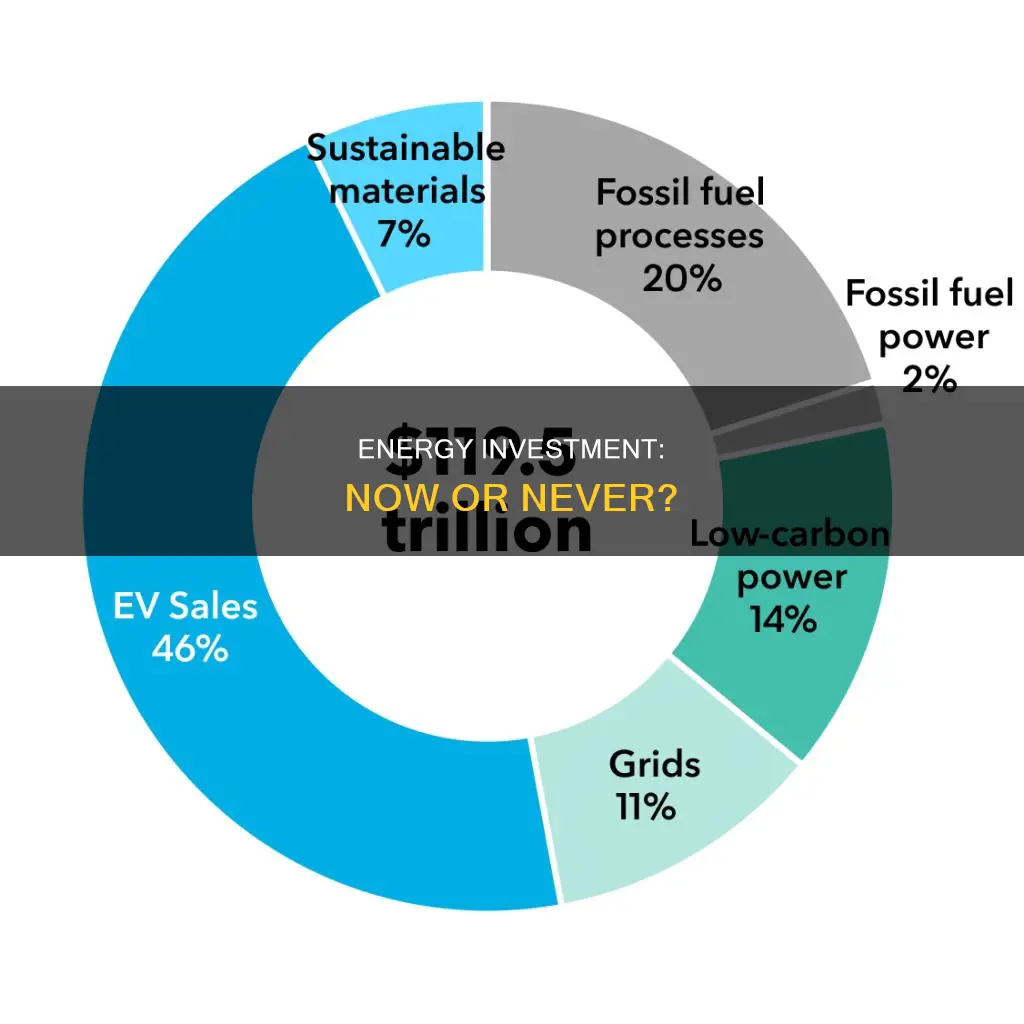
Investing in energy stocks can be a risky business, but it can also be a rewarding one. The energy sector is a vital part of the global economy, and there are several reasons why it might be a good idea to invest in energy stocks right now.
Firstly, the energy sector has been the best-performing sector of the S&P 500 in 2022, and it could still be considered a bargain for those with patience. It has the highest dividend yield of any S&P 500 sector, the highest estimated FCF yield, and the most expected FCF headroom.
Secondly, the energy sector has huge markets and is crucial to the global economy. It has long-term sustained demand and growing global demand as countries like China and India continue to develop.
Thirdly, energy stocks have the potential for high dividends or company growth. When energy prices go up, energy companies can reap the benefits and pay higher dividends to investors or invest in future growth.
However, it's important to remember that energy stocks are volatile and sensitive to changes in the broader market. They are also prone to environmental accidents and shifting consumer preferences for renewable energy sources.
Some top energy stocks to consider include Exxon Mobil, Chevron, ConocoPhillips, and Enbridge.
What You'll Learn

Oil and gas energy companies
The oil and gas industry is a crucial sector for the global economy, providing the primary fuel source worldwide. It is a complex and capital-intensive industry, with a high level of risk and volatility. However, it can be a good investment, especially for long-term investors.
Risks and Challenges
The oil and gas sector carries several significant risks that investors should be aware of:
- Commodity Price Volatility: Oil and gas prices can fluctuate due to changes in supply and demand, impacting stock prices. For example, the industry experienced substantial price volatility in 2014-2015 due to a supply glut, and prices collapsed during the COVID-19 lockdown in 2020.
- Dividend Cuts: Companies in this sector often pay dividends, but there is a risk of dividend cuts if companies cannot generate enough revenue due to low commodity prices. This can negatively impact investors.
- Accidents and Environmental Impact: Oil spills and other accidents can occur, causing devastating environmental damage and leading to significant costs and negative publicity for companies.
- Regulatory and Legal Issues: Oil and gas companies are subject to regulatory and legal risks, especially in the aftermath of accidents.
- Exploration Uncertainty: Oil and gas exploration is unpredictable, and investments in exploration blocks may not pan out, resulting in losses.
- Safety Concerns: Oil and gas are flammable and toxic, and the machinery and infrastructure involved present safety risks.
- Cyclicality: The industry tends to be cyclical, with booms and busts, which can impact investors.
Benefits and Opportunities
Despite the risks, there are several potential advantages to investing in oil and gas companies:
- Stable Markets: The oil and gas markets are generally less volatile than the stock market and are less affected by destabilizing market forces, providing insulation from inflation and external factors.
- Strong Returns: Wise investments in this sector can lead to stable income and higher return rates. Technological advancements have also improved associated risks.
- Tax Advantages: There are tax benefits associated with oil and gas investments, such as intangible drilling cost deductions and tax-free portions of gross income.
- High Dividend Yields: Oil companies can generate significant cash flow during high oil price periods, leading to attractive dividend yields for investors.
- Global Demand: Despite the diversification of energy sources, the demand for fossil fuels remains high, and global oil demand is predicted to increase.
Key Companies
When considering investing in oil and gas companies, it is essential to focus on those with strong financial profiles and the ability to withstand market downturns. Some of the leading companies in the industry include:
- ExxonMobil: One of the world's largest oil companies, ExxonMobil has a global presence in upstream, midstream, and downstream operations. It has been working to boost efficiency and reduce costs, generating excellent returns for investors.
- ConocoPhillips: A leading exploration and production company with a strong financial profile, allowing it to compete globally. ConocoPhillips has a low average cost per barrel and can generate profits in various market environments.
- Chevron: A leading global energy company with integrated upstream, midstream, and downstream operations. Chevron has been investing in carbon capture, green hydrogen, and renewable fuels to adapt to the energy transition.
- Phillips 66: A top downstream refining company with strong financial and operating capabilities, making it one of the most cost-effective refineries in the sector.
- Cheniere Energy: A niche company specializing in the transportation and storage of liquefied natural gas, benefiting from the increased demand for LNG in Europe.
Investing in oil and gas energy companies requires a thorough understanding of the industry's dynamics and associated risks. While the sector is volatile and faces long-term challenges due to the transition to cleaner energy sources, it remains a crucial part of the global economy. Investors should carefully consider their risk tolerance, investment goals, and time horizons before deciding whether to invest in this sector.
Green Energy: Why the Hesitation?
You may want to see also

Renewable energy stocks
Secondly, renewable energy stocks can be a good way to diversify your portfolio. When oil and other traditional energy resources experience volatility, renewable investments may act as a stabilizing force. Renewable energy is also becoming more affordable, with the price of solar energy and solar panels dropping, and wind energy becoming one of the fastest-growing and cheapest energy sources in the world.
- Brookfield Renewable Partners L.P. (BEP)
- Algonquin Power & Utilities Corp. (AQN)
- NextEra Energy Partners, LP (NEP)
- Clearway Energy Inc. (CWEN)
- Atlantica Sustainable Infrastructure PLC (AY)
- Ormat Technologies, Inc. (ORA)
- Avangrid AGR
- Eversource Energy ES
- Evergy EVRG
- OGE Energy OGE
- Gilead Sciences GILD
- First Solar Inc. (FSLR)
- Fluence Energy Inc. (FLNC)
- Hannon Armstrong Sustainable Infrastructure Capital Inc. (HASI)
- Nexans SA (NEXNY)
- Cheniere Energy Inc. (LNG)
- Enbridge
It is important to note that investing in individual stocks is inherently risky and should be done with caution. Investors should conduct thorough research and consider factors such as the company's financial health, business model, and growth prospects before making any investment decisions.
Smart Places to Invest $10K
You may want to see also

Fossil fuels vs green energy companies
Fossil fuels are the fossilized remains of plants and animals that walked the planet millions of years ago. Coal, oil, and natural gas are all fossil fuels. The burning of these fuels releases carbon emissions, which are the primary source of carbon emissions and the main cause of global warming. Drilling, mining, and fracking for fossil fuels also take a toll on landscapes and ecosystems.
Renewable energy sources, on the other hand, are much cleaner. They are harnessed from inexhaustible natural processes, such as the sun, wind, and water, and can be used time and time again without depletion. Solar and wind power, for example, are totally clean sources of energy. While renewable resources are expensive to install, they are generally cheap to use. Sources like solar and wind can produce energy “for free” for the duration of the panel or turbine’s life.
In the past, renewable energy was more expensive than fossil fuels. However, in 2016, a major commercial solar farm offered photovoltaic energy at $0.029 cents/kWh, levelling out the cost between renewable energy and fossil fuels. Since then, renewable energy has only become more affordable. Government subsidies, in the form of tax breaks or direct payments, have encouraged consumers and businesses to switch to renewable energy sources.
In addition, renewable energy is becoming more popular and reliable. Solar energy and wind power may soon become a standard source of power. As technology improves, renewable energy will become more efficient and reliable, and prices will continue to decrease.
When it comes to investing, the energy sector is a challenging one, especially when it comes to oil and natural gas companies. Energy prices can fluctuate, and volatility can have a massive impact on the sector and the global economy. However, the energy sector can also be a good investment. In 2021, it was the best-performing sector, and it might still be a bargain for those who can be patient. The energy sector combines low prices with lofty dividend yields supported by high free cash flow.
- Chevron Corporation (CVX)
- ExxonMobil (XOM)
- Cheniere Energy (LNG)
- Occidental Petroleum (OXY)
- Brookfield Renewable
- ConocoPhillips
- NextEra Energy
- Enbridge
Green Buildings: Smart Investment, Healthy Future
You may want to see also

Energy stocks and market volatility
Energy stocks are a critical component of any well-rounded investment portfolio. The energy industry is vital to the global economy, producing and supplying the fuels and electricity needed to keep the economy running. However, investing in energy stocks comes with a unique set of risks, including market volatility.
The Impact of Market Volatility on Energy Stocks
Energy prices are highly volatile, and energy stocks tend to be sensitive to changes in the broader market. This volatility can have a massive impact on the energy sector and the global economy. For example, during the early days of the COVID-19 pandemic, oil and natural gas prices plunged due to decreased demand. In contrast, energy prices soared in 2022 as consumption recovered and reached new highs after Russia's invasion of Ukraine.
The relationship between energy stocks and volatile energy prices has evolved over time. In the past, energy stocks were highly sensitive to oil price fluctuations. However, most oil and gas companies have taken advantage of high prices to repair their balance sheets and reduce financial leverage. As a result, they are now less sensitive to price volatility and can operate profitably even with lower oil prices.
Factors to Consider When Investing in Energy Stocks
When investing in energy stocks, it is essential to consider the following factors to navigate market volatility:
- Diversification: Invest across different segments of the energy sector, including renewables, traditional oil and gas, and utilities.
- Low Costs and Strong Balance Sheets: Prioritize companies with low operating costs and strong financial profiles, including a high investment-grade credit rating, liquidity, and manageable debt.
- Cash Returns: Look for companies with high dividend yields and strong cash flow that can be used for share buybacks or reinvestment in the business.
- Durability: Focus on companies with low-risk business models, diversified operations, low production costs, and stable revenue streams.
- Renewable Energy Transition: Consider the shift towards cleaner energy sources and prioritize companies investing in renewable energy projects and technologies.
- Risk Management: Understand the risks associated with the energy sector, including environmental concerns, regulatory changes, and the impact of innovation and technology on long-term demand.
Energy stocks offer compelling long-term returns, but investors need to be mindful of the risks and volatility associated with the energy sector. By carefully selecting companies with strong financial profiles, low costs, and a focus on sustainability, investors can navigate market volatility and capitalize on the growth potential of the energy industry.
Crude Oil: Invest Now?
You may want to see also

Energy stocks and environmental concerns
The energy sector is vital to the global economy, providing the fuel and power needed to drive trade and travel. However, it also has a significant impact on the environment, with anthropogenic factors being primarily responsible for the current environmental issues. As a result, there is a growing focus on renewable energy sources and a transition towards cleaner, more sustainable energy practices.
The Impact of the Energy Sector on the Environment
The energy sector, particularly the burning of fossil fuels such as coal, oil, and natural gas, is a major contributor to greenhouse gas emissions, which have led to climate change and global warming. This has resulted in rising temperatures, more frequent and intense heat waves, droughts, and extreme weather conditions. It has also contributed to the melting of glaciers, sea ice, and polar ice caps, leading to a rise in global sea levels.
The Energy Transition
There is a growing consensus that a transition to renewable energy sources is necessary to mitigate the effects of climate change. This involves shifting from an energy mix based on fossil fuels to one that relies primarily on renewable energy sources such as solar, wind, hydroelectric, and geothermal power. This transition not only benefits the environment but also has the potential to boost the economy and create new industries.
Environmental Impact of Stock Market Capitalization
Stock market capitalization can play a role in the energy transition and improving the environment. Initially, increased economic activity using conventional or less efficient technologies may lead to higher emissions. However, as investor confidence grows, companies can access more affordable financing, allowing them to adopt green technologies and reduce their environmental impact.
Investing in Renewable Energy Stocks
Renewable energy stocks offer an opportunity to invest in a greener future while potentially diversifying investment portfolios. Some top renewable energy companies include:
- NextEra Energy: One of the world's largest producers of wind and solar energy, with a strong track record of creating shareholder value.
- Brookfield Renewable: A global leader in renewable energy, with a focus on hydroelectric power and a commitment to expanding its wind, solar, and energy storage expertise.
- Clearway Energy: One of the largest owners of renewable energy generating facilities in the U.S., with a strong financial profile and a commitment to increasing its renewable energy operations.
- First Solar: A leading manufacturer of thin-film solar panels, with a strong balance sheet and the flexibility to expand its operations to meet growing demand.
- SolarEdge Technologies: A developer of optimized inverter systems that maximize the power produced by solar panels, leveraging its expertise to expand into smart energy solutions.
Environmental Concerns and Energy Stocks
When investing in energy stocks, it is essential to consider the environmental impact of the industry. By investing in renewable energy stocks, investors can support companies that are committed to reducing their carbon footprint and transitioning to cleaner energy sources. Additionally, investing in renewable energy can help diversify portfolios and stabilize investments, as renewable energy sources become more affordable and widely adopted.
In conclusion, the energy sector is crucial to the global economy, but it also has significant environmental implications. The transition to renewable energy sources is essential to mitigate climate change and improve sustainability. Stock market capitalization can play a role in this transition by providing financing for green technologies. Investing in renewable energy stocks offers an opportunity to support environmentally conscious companies while potentially diversifying investment portfolios.
Diversifying Savings: Beyond Stocks and Bonds
You may want to see also







